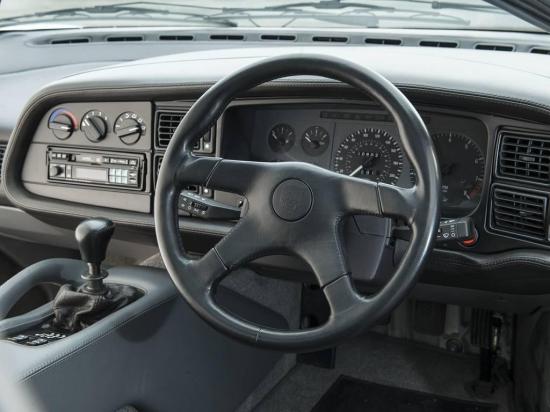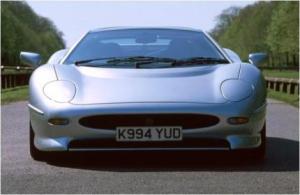
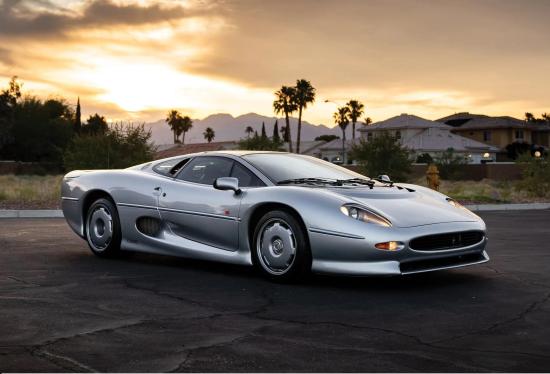
Jaguar XJ220 specs
| Car type | Coupe |
| Curb weight | 1470-1555 kg (3241-3428 lbs) |
| Introduced | 1992 |
| Origin country | United Kingdom |
| Gas mileage | 31.0-16.5 l/100 km (8-14 mpg US / 9-17 mpg UK) |
| CO2 emissions | 429 g/km |
| Views | 93.3k |
Lap times
| Track | Time |
|---|---|
| Bedford Autodrome West Circuit (06/2008 - 05/2015) | 1:26.70 |
| Bruntingthorpe | 1:13.42 |
| Grand Tour Eboladrome | 1:35.10 w |
| Mireval (1994) | 1:30.40 |
| Nürburgring Nordschleife | 7:46.37 |
| Laguna Seca (post 1988) | 1:38.00 est |
| Hockenheim Short | 1:10.00 est |
| Tsukuba | 1:03.00 est |
Performance
| 0 - 80 kph | 3.1 s |
| 0 - 100 kph | 3.8 s |
| 0 - 120 kph | 5.2 s |
| 0 - 160 kph | 8.2 s |
| 0 - 180 kph | 9.9 s |
| 0 - 200 kph | 12.0 s |
| 1000 m | 20.6 s |
| 60 - 100 kph (4) | 5.9 s |
| 60 - 100 kph (5) | 10.0 s |
| 80 - 120 kph (4) | 4.2 s |
| 80 - 120 kph (5) | 7.0 s |
| Est. 100 - 200 kph | 7.8 s |
| 0 - 30 mph | 1.9 s |
| 0 - 40 mph | 2.5 s |
| 0 - 50 mph | 3.0 s |
| 0 - 60 mph | 3.6 s |
| 0 - 70 mph | 4.6 s |
| 0 - 80 mph | 5.5 s |
| 0 - 90 mph | 6.5 s |
| 0 - 100 mph | 7.3 s |
| 0 - 110 mph | 9.3 s |
| 0 - 120 mph | 10.8 s |
| 0 - 130 mph | 12.6 s |
| 0 - 140 mph | 14.9 s |
| 0 - 150 mph | 17.4 s |
| Est. 1/8 mile | 8.4 s @ 102.5 mph |
| 1/4 mile | 11.7 s @ 125.0 mph |
| Top speed | 349 kph (217 mph) |
| 0 - 100 mph - 0 | 15.1 s |
| Est. max acceleration | 0.71 g (7 m/s²) |
| 100 kph - 0 | 36 m (119 ft) |
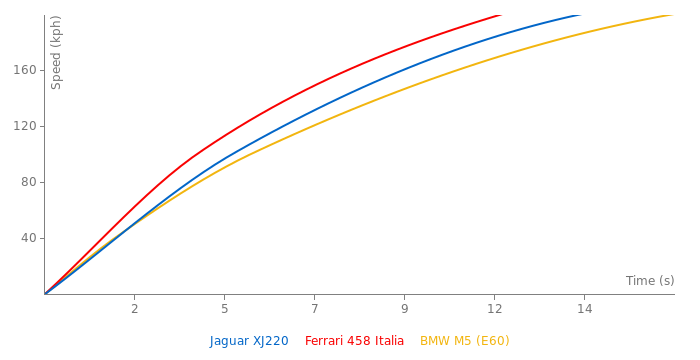
Powertrain specs
| Engine type | 3.5 V6 Twin-Turbocharged |
| Displacement | 3.5 l (214 ci) |
| Power | 549 ps (542 bhp / 404 kw) @ 7000 rpm |
| Torque | 641 Nm (473 lb-ft) @ 4500 rpm |
| Power / liter | 157 ps (155 hp) |
| Power / weight | 363 ps (358 bhp) / t |
| Torque / weight | 424 Nm (313 lb-ft) / t |
| Efficiency | 23 PS per l/100 km |
| Transmission | 5 |
| Layout | middle engine, rear wheel drive |
XJ220 competition
Crispi74 1y ago
Auto Pur test 1/94
0-100 kph 3.9s
0-200 kph 10.6s
Top speed 348 kph
Weight cliamed 1375 kgs
PS. IMHO "S spec" engine fitted in the car.
wallenieswiftie 2y ago
0 - 80 kph 3.1 s
0 - 100 kph 3.8 s
0 - 120 kph 5.2 s
This car did 100 km/h in first gear. This means theoretically, the 80-120km/h time of 2.1s is conservative. It's more like 1.6s. The Ferrari Enzo and the Porsche Carrera GT do the same 80-120 time.
Crispi74 2y ago
I found new info on the XJ220.
Instead of 580 hp that Autocar claimed on power, customer cars seems to be rated to be close to 610 hp.
Decatting these cars putting a stright through exhaust power will pick up to 680 hp or exactly the S-spec.
Looking at the diagram of telemetry that waa published on the pages of Car magazine, times seemed to be close to (speed in mph):
0-60 5,5s
0-100 9,0s
0-130 12,5s
0-160 20s
0-180 23s
0-200 29,5s
Top speed 217 mph
wallenieswiftie 3y ago
Check out these in-house estimations
0-60 mph: 3.67 sec (pre-shift) or 4.10 sec (post-shift, manual only)
0-100 mph: 7.62 sec-> 60-100 = 3.52 sec
Street 1/4-mile: 11.82 sec @ 126.32 mph
Top speed: 198 mph (theoretical maximum velocity: 210 mph)
https://docs.google.com/document/d/1ERFzdIin1zS36ZjmkjahNwjwJAVxwoPCgNV2zJzn2Jo/edit?usp=sharing
Although the XJ220 was supposed to hit 220, it didn't. Autocar suggested it would hit 223 against the wind, but that still hasn't been confirmed. It did 217 with a modification, so that doesn't count either. 213 was the claimed top speed for the production car and even that's pushing it considering the bad aerodynamics. (I had this problem with the Ferrari F50, it couldn't reach the claimed 202.)
Whatever 3y ago
Tiff tests XJ220, Espirit and their racing versions around Silverstone South Circuit. He mentions Racing version of Jaguar is about 12s faster than road version. Wonder if it is possible to extract laptimes from this video.(if there are no segments skipped or something).
https://youtu.be/HpMuck3q9F4
Fiesta ST 3y ago
- 1990/1991 Engine: 6.2 L Jaguar V12
- 1992-1994 Engine: 3.5 L twin-turbocharged Jaguar V6
The Jaguar XJ220 Development Mule Was a Ford Van
😂 😂 😂 😂 😂 😂 😂 😂 😂
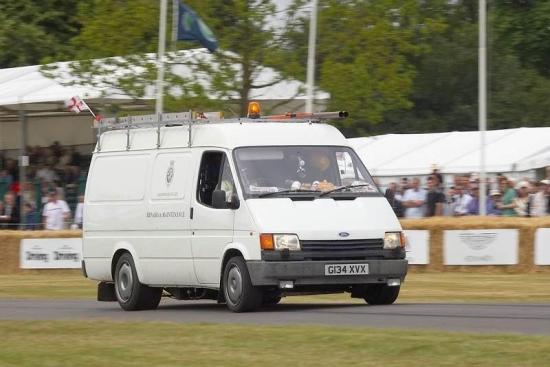
hostboy 3y ago
Shaggy • 10y ago
"Amazing car, 542 horsepower will only get a new car to about 190 MPH, and it takes about 700 horsepower to get a new supercar to 215 MPH, the Jaguar XJ220 has the aerodynamics of a fighter jet, and it's light, 3,234 LBS."
This is because the XJ220 was underrated and not actually making only 550 horsepower. The top-speed record car was stated to make 50 hp more, but the XJ220 actually makes 650-700.
hostboy 3y ago
Jaguar XJ220 (1992):
Claimed Power: 542 bhp / 550 PS / 404 kW
Actual Power: 697 bhp / 707 PS / 520 kW
Estimated Weight: 1578 kg with driver and fuel
Source of Estimations: TorqueStats *with several adjustments
Imperial acceleration figures (for U.S.):
▪ 0-30 mph: 1.636 s
▪ 0-60 mph: 3.083 s
▪ 0-100 mph: 6.700 s
▪ 0-150 mph: 15.075 s
▪ 0-200 mph: 32.244 s
▪ Top speed: 216.880 mph *average of both directions
▪ 1/4 mile: 11.320 s @ 129.983 mph
▪ 1 mile: 27.015 s @ 189.106 mph
▪ 1' rollout: 0.293 s
Metric acceleration figures (for rest of the world):
▪ 0-100 km/h: 4.091 s
▪ 0-200 km/h: 10.335 s
▪ 0-300 km/h: 26.109 s
▪ Top speed: 367.489 km/h
▪ 0-380 m: 11.302 s @ 209.147 km/h
▪ 0-400 m: 11.569 s @ 211.603 km/h
▪ 0-1000 m: 20.210 s @ 279.678 km/h
TypeF173 3y ago
Quote>"The XJ220 scores goals which the Ferrari doesn't even aim at."
TypeF173 3y ago
Top-Speed Testing the Bugatti EB 110 S, Jaguar XJ220, Ruf 911 BTR, and Ferrari 456 GT
TypeF173 4y ago
So, to get too the very bottom of all these metrics and numbers I absolutely had to get them from Source. So I did. I acquired a copy of Autocar and Motor from June 1993.
I couldn't find any quailty scans anywhere. So I was left with little or next to no choice.
Anyway front page plus acceleration scans> https://postimg.cc/gallery/LmgQCCj
She's an old lady now but when I first saw those figures I was completely blown away!
Hopefully this is a demonstration on how far I'm willing to go to get the information that's required.
:)


